AUDI TT ROADSTER 2011 Owners Manual
Manufacturer: AUDI, Model Year: 2011, Model line: TT ROADSTER, Model: AUDI TT ROADSTER 2011Pages: 260, PDF Size: 64.11 MB
Page 231 of 260
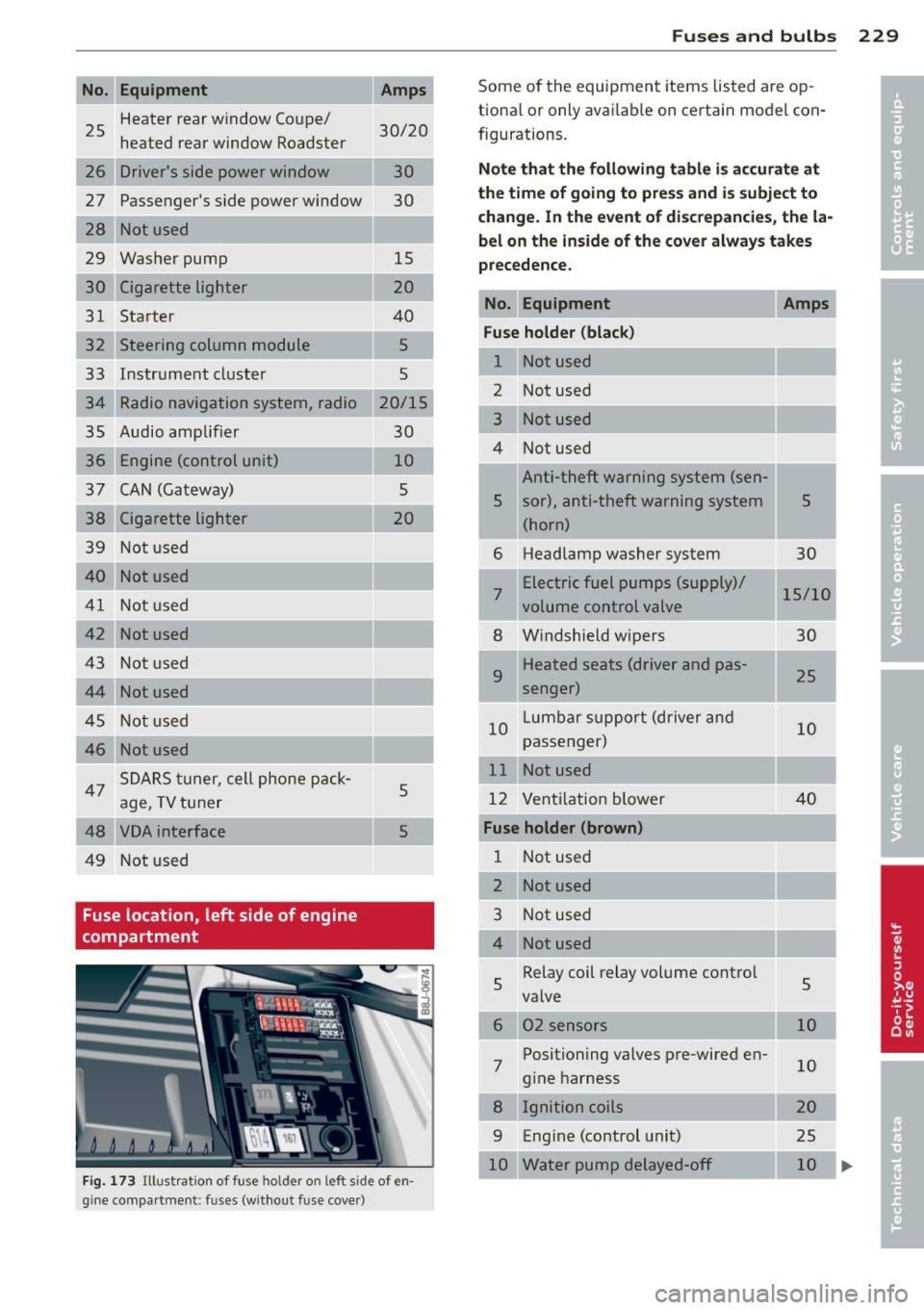
No.
25
Heater rear window Coupe/
heated rear window Roadster
26 Driver's side power window
27 Passenger's side power window
28 Not used
29 Washer pump
30 Cigarette lighter
31 Starter
32 Steering column module
33 Instrument cluster
34 Radio navigation system, radio
35 Audio amplifier
Engine (control unit)
37 CAN (Gateway)
38 Cigarette lighter
39 Not used
40 Not used
41 Not used
42 Not used
43 Not used
44 Not used
45 Not used
46 Not used
47 SOARS tuner, cell phone p ack-
age, TV tuner
48 VOA interface
49 N ot used
Fuse location, left side of engine
compartment Amps
30/20
30 15
40
30 10 5
20
-
5
5
F ig. 173 Illustrat ion of fuse holder on left side of en
g ine co mpa rtment : fuses (without fuse cover)
Fuse s and bulb s 229
Some of the equipment items listed are op
tiona l or only avai lab le on certain model con
figurations.
Note tha t the foll owing table i s ac cur ate at
the time of going t o press and is subject to
change . In the event of di screpancie s, the la·
bel on the inside of the cover always takes
precedence.
No . Equipment Amps
Fuse holder (black )
1 Notused -
----------'
2 Not used
3 Not used
4 Not used
Anti-theft warning system (sen-
5 sor), anti-theft wa rning system
(horn)
6 H eadlamp washer system
7
Electric fuel pumps (supply)/
volume control valve
8 W indshield wipers
9
Heated seats (driver and pas-
senger)
10
L umbar support (driver a nd
passenger)
11 Not used
12 Vent ilation blower
Fuse holder (brown )
1
2
3
4
5
6
7
9 N
ot used
Not used
Not used
Not used
Relay coil relay volume contro l
va lve
Position ing valves pre-wired en
g ine harness
I gnition coils
Eng ine (control unit)
10 Water pump delayed-off
5
30
15/10
30
25
10
40
-
5
10
10
20
25 10
1111-
Page 232 of 260
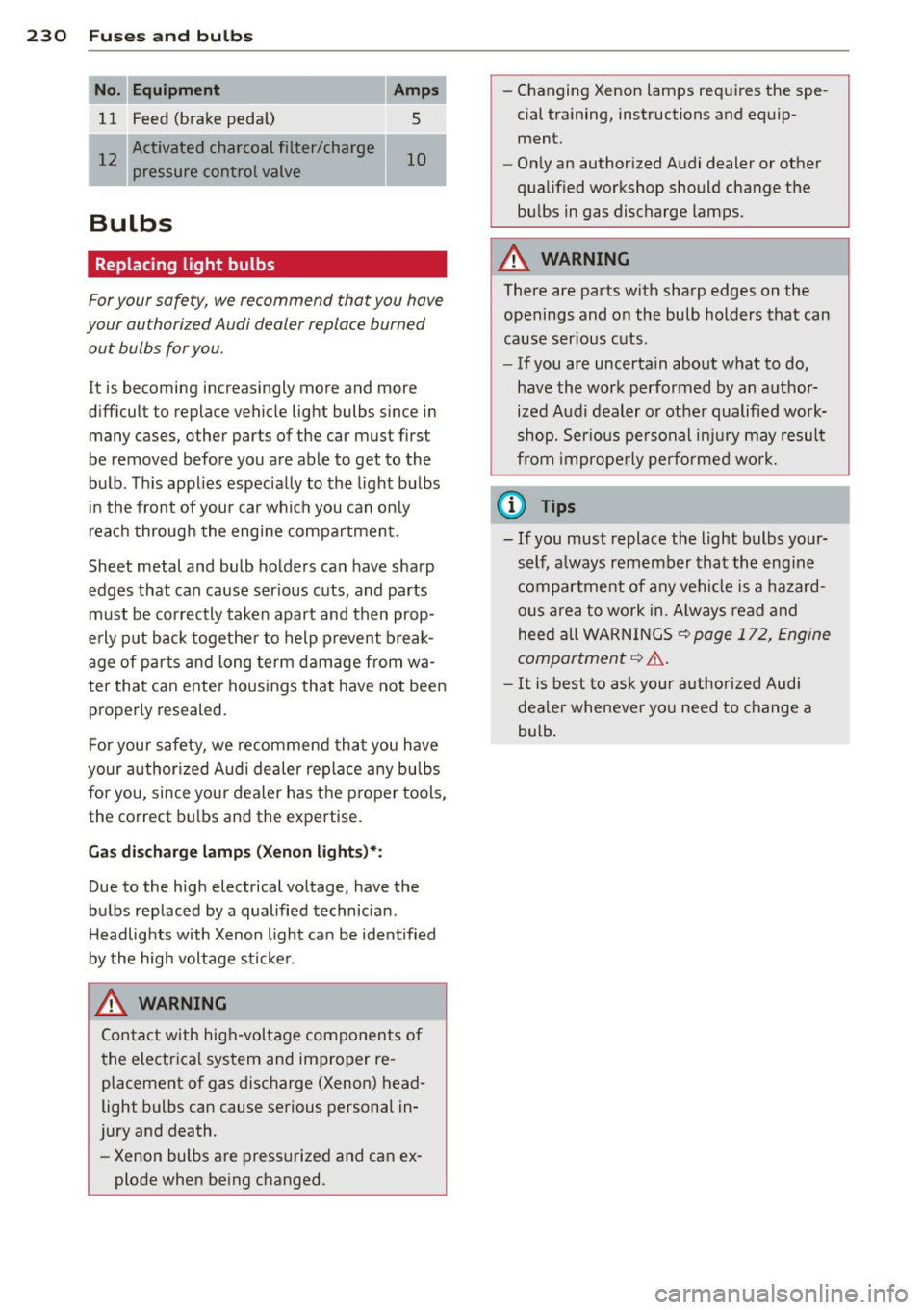
230 Fuses and bulbs
No. Equipment Amps
11 Feed (brake pedal) 5
-
12 Activated cha
rcoal filter/charge I pressure control valve 10
Bulbs
Replacing light bulbs
For your safety, we recommend that you have
your authorized Audi dealer replace burned
out bulbs for you .
It is becoming increasingly more and more
difficult to replace vehicle light bulbs since in
many cases, other parts of the car must first
be removed before you are able to get to the
bulb . This applies especially to the light bulbs
in the front of your car which you can only
reach through the engine compartment.
Sheet metal and bulb holders can have sharp
edges that can cause ser ious cuts, and parts
must be correctly taken apart and then prop
e rly put back together to help prevent break
age of parts and long term damage from wa
ter that can enter housings that have not been
properly resealed.
For your safety, we recommend that you have
your authorized Audi dealer replace any bulbs
for you, since your dealer has the proper tools,
the correct bulbs and the expertise.
Gas discha rge lamps (Xenon lights}*:
Due to the high electrical voltage, have the
bulbs replaced by a qualified technician.
H eadlights with Xenon light can be identified
by the high voltage sticker.
A WARNING
Contact with high-voltage components of
the electrical system and improper re
placement of gas discharge (Xenon) head
light bulbs can cause serious personal in
jury and death.
- Xenon bulbs are pressurized and can ex
plode when being changed. -
Changing Xenon lamps requires the spe
cial tra ining, instructions and equip
ment.
- Only an authorized Audi dealer or other
qualified workshop should change the
bulbs in gas discharge lamps.
A WARNING
=
There are parts with sharp edges on the
openings and on the bulb holders that can
cause ser ious cuts.
- If you are uncertain about what to do,
have the work performed by an author
ized Audi dealer or other qualified work
shop. Serious personal injury may result
from improperly performed work.
@ Tips
- If you must replace the light bulbs your
self, a lways remember that the engine
compartment of any vehicle is a hazard
ous area to work in. A lways read and
heed all WARNINGS
c:::> page 172, Engine
compartment
c::> &. .
-It is best to ask your authorized Audi
dealer whenever yo u need to change a
bulb .
-
Page 233 of 260
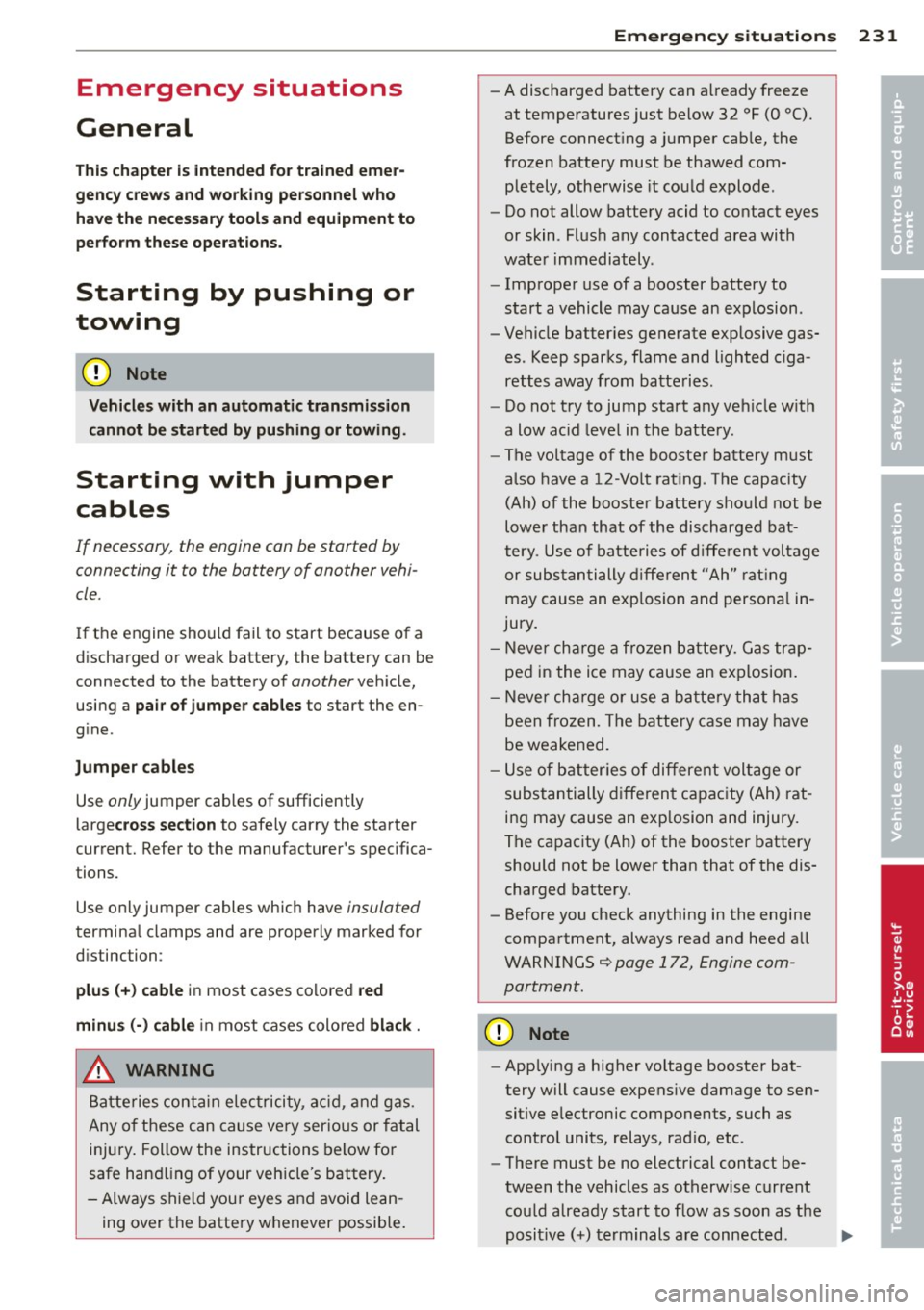
Emergency situations
General
This chapter is intended for trained emer
gency crews and working personnel who
have the necessary tools and equipment to
perform these operations.
Starting by pushing or
towing
(D Note
Vehicles with an automatic transmission
cannot be started by pushing or towing .
Starting with jumper
cables
If necessary, the engine can be started by
connecting it to the battery of another vehi
cle.
If the engine should fail to start because of a
discharged or weak battery, the battery can be
connected to the battery of
another vehicle,
using a
pair of jumper cables to start the en
gine.
Jumper cables
Use only jumper cables of sufficiently
largec ross section to safely carry the starter
current. Refer to the manufacturer's specifica
tions.
Use only jumper cables which have
insulated
termina l clamps and are properly marked for
distinction :
plus(+) cable in most cases colored red
minus(-) cable
i n most cases colored black.
_& WARNING
Batteries contain electricity, ac id, and gas.
Any of these can cause very serious or fatal
injury. Follow the instructions below for
safe handling of your vehicle's battery.
- Always shield you r eyes and avoid lean
ing over the battery whenever possible.
Emergency situations 231
-A discharged battery can already freeze
at temperatures just below 32 °F (0 °C).
Before connecting a jumper cable, the
frozen battery must be thawed com
pletely, othe rwise it could explode .
- Do not allow battery acid to contact eyes
or skin . Flush any contacted area with
water immediately .
- Improper use of a booster battery to
start a vehicle may cause an explosion.
- Vehicle batter ies generate explosive gas
es. Keep sparks, flame and lighted ciga
rettes away from batteries.
- Do not try to jump start any veh icle w ith
a low ac id level in the battery.
- The voltage of the booster battery must
also have a 12-Volt rating. The capacity
(Ah) of the booster battery should not be
lower than that of the discharged bat
tery . Use of batteries of different voltage
or substantially different "Ah" rat ing
may cause an exp losion and personal in
jury.
- Never charge a frozen battery. Gas trap
ped in the ice may cause an explosion.
- Never charge o r use a battery that has
been frozen . The battery case may have
be weakened.
- Use of batter ies of different voltage or
substantially different capacity (Ah) rat
ing may cause an exp losion and injury .
The ca pa city (Ah) of the booster battery
should not be lower than that of the dis
charged battery.
- Before you check anything in the engine
compartment, always read and heed all
WARNINGS¢
page 172, Engine com
partment.
(D Note
- App lying a higher voltage booster bat
tery will cause expensive damage to sen
sit ive electronic components, such as
control units, relays, rad io, etc .
- There must be no electrical contact be
tween the vehicles as otherwise current
could already start to flow as soon as the
posit ive(+) terminals are connected. ..,. •
•
Page 234 of 260
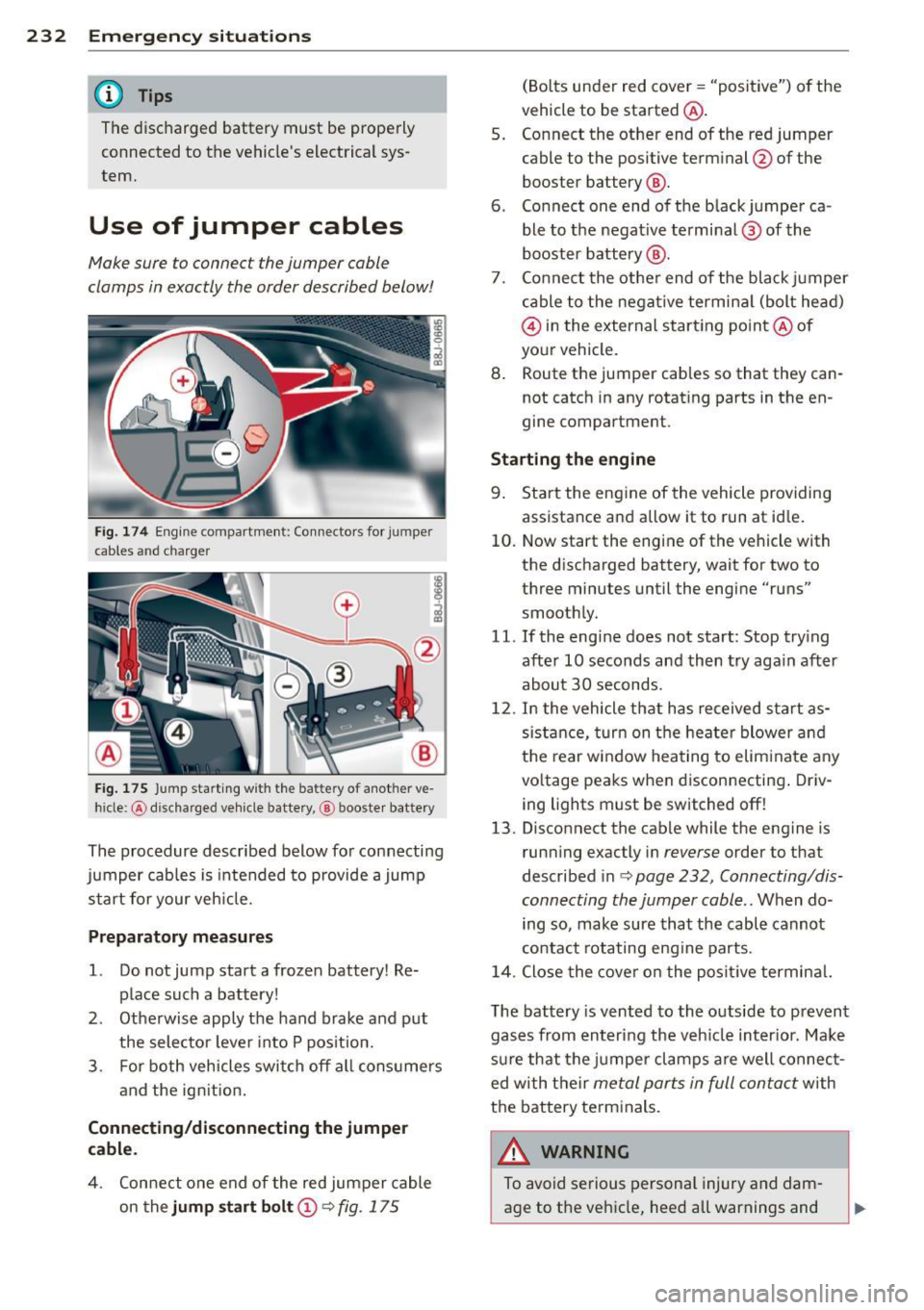
232 Emergency situations
@ Tips
The discharged battery must be properly
connected to the vehicle's electrical sys
tem.
Use of jumper cables
Make sure to connect the jumper coble
clomps in exactly the order described below!
Fig. 174 Engine compart ment: Co nnectors for jumper
cables and charger
Fig. 175 Jump starting with the battery of another ve
hicle: @discharged veh icle battery, ® booste r battery
The procedure described below for connecting
jumper cables is intended to provide a jump
start for your veh icle.
Preparatory measures
1. Do not jump start a froze n battery! Re
place such a battery!
2 . Otherwise apply the hand brake and put
the selector lever into P position.
3. For both vehicles switch off all consumers
and the ign ition.
Connecting/disconnecting the jumper
cable .
4. Connect one end of the red jumper cable
on the
jump start bolt (D 9 fig. 175
(Bolts under red cover = "positive") of the
vehicle to be started @.
5. Connect the other end of the red jumper
cable to the positive terminal @of the
booster battery @.
6. Connect one end of the black jumper ca
ble to the negat ive terminal @of the
booster battery @.
7. Connect the other end of the black jumper
cable to the negative terminal (bolt head)
@ in the external start ing point @ of
your vehicle.
8. Route the jumper cables so that they can
not catch in any rotat ing parts in the en
gine compartment.
Starting the engine
9. Start the engine of the vehicle providing
assistance and allow it to run at id le .
10. Now start the engine of the vehicle with
the discharged battery, wait for two to
three minutes until the engine "runs"
smoothly.
11. If the eng ine does not start: Stop try ing
after 10 seconds and then try again after
about 30 seconds.
12. In the vehicle that has received start as
sistance, turn on the heater blower and
the rear window heating to elim inate any
vo ltage peaks when disconnecting . Driv
ing lights must be switched off!
13 . Disconnect the cable while the engine is
running exactly in
reverse order to that
described inc:>
page 232, Connecting/dis
connecting the jumper coble ..
When do
ing so, make sure that the cable cannot
contact rotating eng ine parts.
14. Close the cover on the posi tive terminal.
The battery is vented to the outside to prevent
gases from entering the vehicle inter ior. Make
sure that the jumper clamps are well connect
ed with their
metal parts in full contact with
the battery terminals.
A WARNING ~
To avoid serious personal injury and dam-
age to the vehicle, heed all warnings and
Page 235 of 260
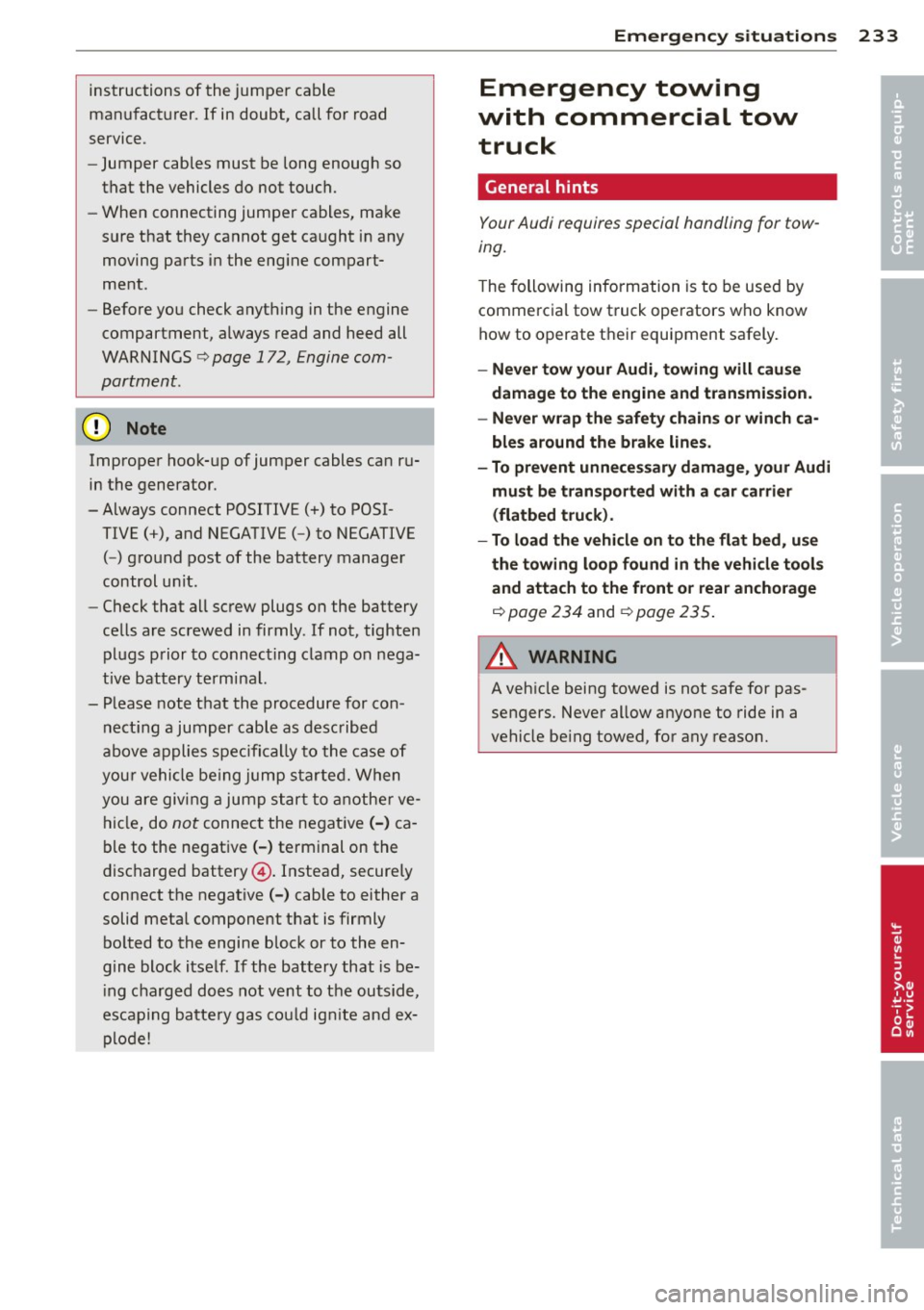
instructions of the jumper cable
manufacturer. If in doubt, call for road
service.
- Jumper cables must be long enough so
that the vehicles do not touch.
- When connecting jumper cables, make
sure that they cannot get caught in any
moving parts in the engine compart
ment.
- Before you check anything in the engine
compartment, always read and heed all
WARNINGS
<=> page 172, Engine com
partment .
@ Note
Improper hook-up of jumper cables can ru
in the generator.
-Always connect POSITIVE(+) to POSI
TIVE(+), and NEGATIVE(-) to NEGATIVE
( - ) ground post of the battery manager
control unit.
- Check that all screw plugs on the battery
cells are screwed in firmly . If not, tighten
plugs prior to connecting clamp on nega
tive battery terminal.
- Please note that the procedure for con
necting a jumper cable as described
above applies spec ifically to the case of
your vehicle being jump started. When
you are giving a jump start to another ve
hicle, do
not connect the negative( -) ca
ble to the negative(- ) terminal on the
discharged battery@. Instead, securely
connect the negative (-) cable to either a
solid metal component that is firmly bolted to the engine block or to the en
gine block itself. If the battery that is be
in g charged does not vent to the outside,
escaping battery gas could ignite and ex
plode!
Emergency situations 233
Emergency towing
with commercial tow
truck
General hints
Your Audi requires special handling for tow
ing.
T he following information is to be used by
commercial tow truck operators who know
how to operate their equipment safely.
- Never tow your Audi, towing will cause
damage to the engine and transmission.
- Never wrap the safety chains or winch ca
ble s around the brake lines .
- To prevent unnecessary damage, your Audi
must be transported with a car carrier
(flatbed truck).
- To load the vehicle on to the flat bed, use
the towing loop found in the vehicle tools
and attach to the front or rear anchorage
<=> page 234 and c:> page 235.
A WARNING
A vehicle being towed is not safe for pas
sengers. Never allow anyone to ride in a
vehicle be ing towed, for any reason.
-
•
•
Page 236 of 260

234 Emergency situations
Front towing loop
Do not install the front towing loop until it is
needed.
Fig. 176 Front bumper: removing th e grill
Fig. 177 Front bumper: screwing in the tow ing loop
The towline eye fits into the threaded hole lo
cated on the r ight side of the front bumper
behind the grill .
... Remove the screwdriver and towing loop
from the vehicle toolkit
q page 218 .
... Insert the screwdriver into the slot as shown
and press toward the cente r of the vehicle
¢
fig. 176 . At the same time, pull the grill
forward and out .
.,. Screw the towing loop tight ly into the
threaded hole as far as it will go¢
fig. 177.
When it is no longer needed, unscrew the
towline eye and put it back into the on-board
too lkit. Make sure to have the towline eye
stored in the vehicle at all times.
When installing the grill for the air duct, be
sure that the tabs on the gr ill are first insert
ed into their guides on the vehicle. Then push
the grill into position .
A WARNING
-If the towing loop is not screwed in as far
as it will go, the thread can pull out when
the veh icle is towed -potent ial risk of an
accident.
Front towing loop
Applies to veh icles: w ith 265 hp engine
Only install the front towing loop when it is
needed .
Fig. 178 Right front sect ion: remov ing the air intake
grille
Fig. 179 Right front sect io n with plast ic cove r
A threaded opening with left-hand threads is
located at the front right of the bumper be·
hind the air intake grille. The towing loop is
installed in this opening .
.,. Remove the screwdriver and the towing loop
from the vehicle tool kit
q page 218.
... Reach through the air intake grille, grip the
hor izontal fins and pull it forward to re
move.
... Use the screwdriver to pry the plastic cover
off
q fig. 179.
... Install the towing loop in the threaded
opening and tighten it until it stops
q page 234, fig. 177.
Page 237 of 260
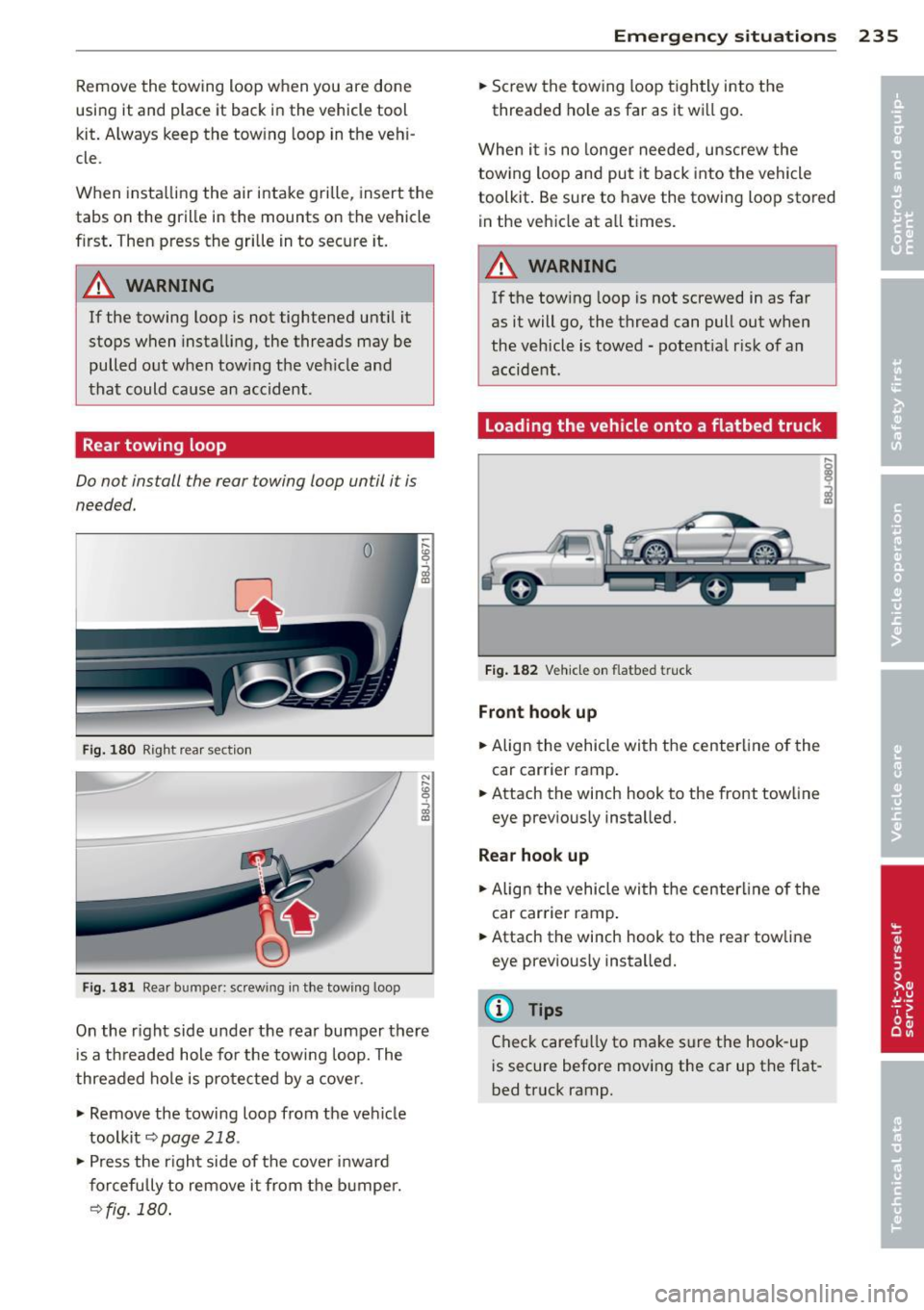
Remove the towing loop when you are done
using it and place it back in the vehicle tool
kit . A lways keep the tow ing loop in the vehi
cle.
When insta lling the air intake grille, insert the
tabs on the grille in the mounts on the vehicle
first . Then press the gri lle in to sec ure it.
A WARNING
If the towing loop is not tightened until it
stops when instal ling, the threads may be
pulled out when tow ing the ve hicle and
t hat could ca use an accident.
Rear towing loop
Do not install the rear towing loop until it is
needed.
Fi g. 180 Right rea r sect ion
Fi g. 18 1 Rea r bumper: screwing in t he tow in g loop
On the r ight side under the rear bumper there
i s a t hreaded hole for the tow ing loop. The
threaded hole is pro tected by a cove r.
"' Remove the towing loop from the ve hicle
toolkit
r:::;,page 218.
"'Press the right side of the cover inward
f orcefully to remove i t from the b umper.
¢fig. 180.
Emergency s itu ations 235
"' Sc rew the towing loop tightly into the
threaded ho le as far as it wi ll go.
When it is no longe r neede d, unscrew the
towing loop and put it back into the vehicle
toolk it . Be sure to have the towing loop sto red
in the vehicle at all times.
A WARNING
If t he tow ing loop is not screwed in as far
as it will go, the thread can pull out when
the vehicle is towed -potent ia l risk of an
accident.
loading the vehicle onto a flatbed truck
I
Fi g. 182 Ve hicle on flatbed truck
Front hook up
"'Align the vehicle wi th t he centerline of the
car carrier ramp.
"' Attach the winch hook to the front towline
eye prev iously insta lled.
Rear hook up
"' Alig n the vehicle wi th the center line of the
car car rier ramp .
"' Attach the winch hook to the rear tow line
eye previous ly insta lled.
(D Tips
Check caref ully to ma ke s ure the hook-up
i s secure before moving the car up the flat
bed truck ramp.
Page 238 of 260
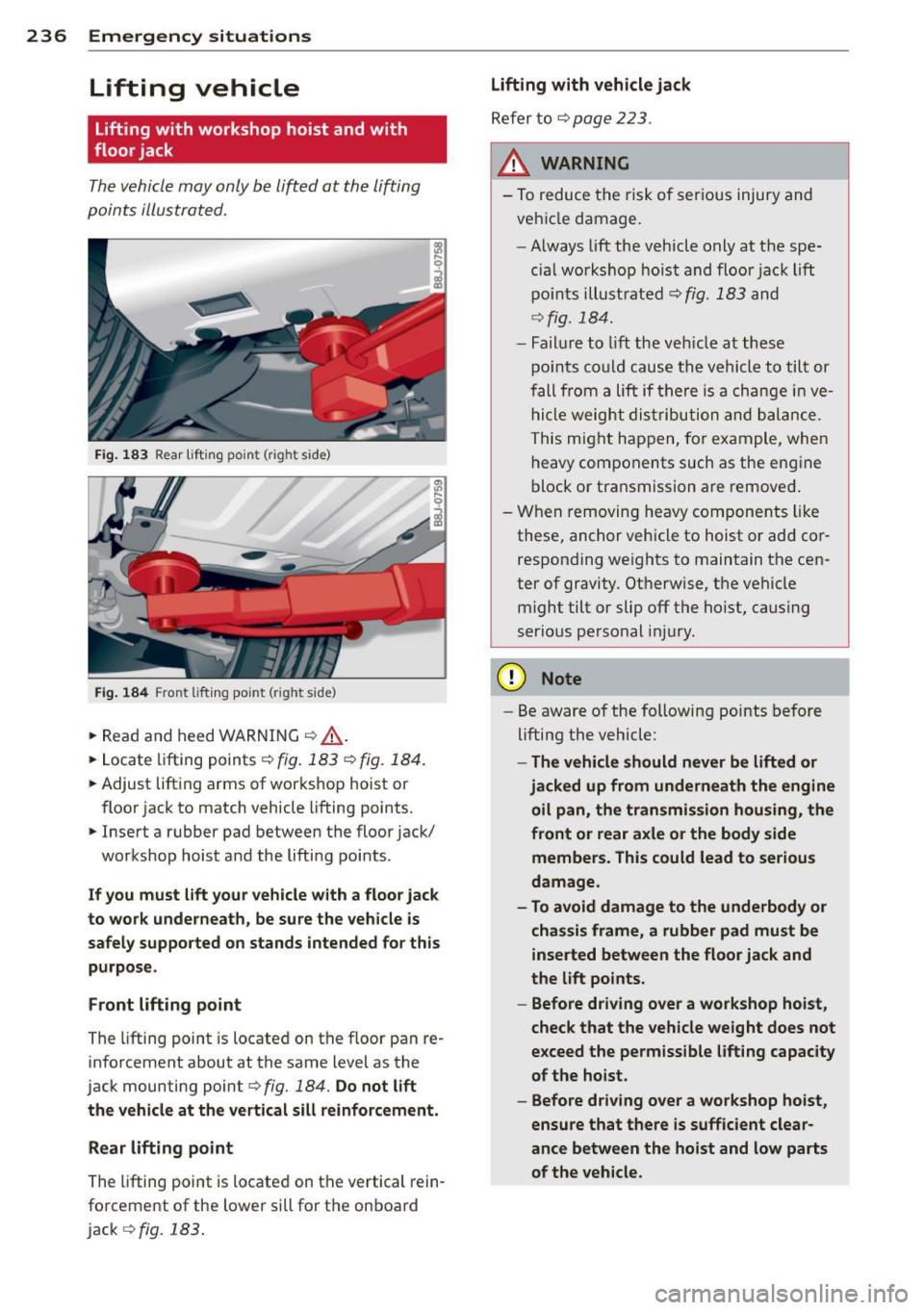
236 Emergency situations
Lifting vehicle
Lifting with workshop hoist and with
floor jack
The vehicle may only be lif ted at the lifting
points illustra ted.
F ig. 18 3 Rear lift in g poin t (ri gh t side)
Fi g. 184 Front lift in g po int (r ig ht s ide)
• Read and heed WARNI NG ¢,& .
• Locate lifting points
q fig . 183 qfig . 184 .
• Adjust lift ing arms of workshop hoist or
floor jack to match vehicle lifting points.
• In se rt a rubber pad between the floor jack/
workshop hoist and the lifti ng po ints.
If you must lift your vehicle with a floor jack
to work underneath, be sure the vehicle is safely supported on stands intended for this
purpose.
Front lifting point
The lifting point is locate d on the floor pan re
info rcement about at the same level as the
jac k mounting point
q fig. 184. Do not lift
the vehicle at the vertical sill reinforcement.
Rear lifting point
The lifting point is locate d on t he vertical rein
forcement of the lower s ill for t he on boa rd
j ac k
¢fig . 183.
Lifting with vehicle jack
Refer to ¢page 223 .
/n.. WARNING
- To reduce the risk of ser io us injury and
veh icle d amage .
- Always lift th e vehicle onl y at t he spe
c ia l works ho p h oist and floor jac k lift
p o ints illust rated¢
fig . 183 and
¢fig. 184.
- Fa il u re t o lift th e veh icle at th ese
p oi nts co ul d cau se the vehicle to tilt or
f a ll from a li ft if th ere is a ch an ge i n ve
h icl e weig ht distr ibu tio n an d ba lan ce.
This mi ght happen, for ex amp le, when
h eavy com ponent s such as the engine
b lock o r transmission are remove d.
- W hen removin g heavy compone nts like
these , anch or vehicle to hoist or ad d co r
respon ding we ights to maintain t he cen
ter of gravity. Ot herwise , th e ve hicle
might tilt or slip off the ho ist, causing
serio us personal injury.
(D Note
-Be aware o f the following points before
lifting the vehicle:
- The vehicle should never be lifted or
jacked up from underneath the engine
oil pan, the transmission housing, the
front or rear axle or the body side members. This could lead to seriou s
damage .
- To avoid damage to the underbody or
chassis frame, a rubber pad must be inserted between the floor jack and
the lift points.
- Before driving over a workshop hoist ,
check that the vehicle weight does not
exceed the permissible lifting capacity
of the hoist .
- Before driving over a workshop hoist,
ensure that there is sufficient clear
ance between the hoist and low parts
of the vehicle.
-
Page 239 of 260
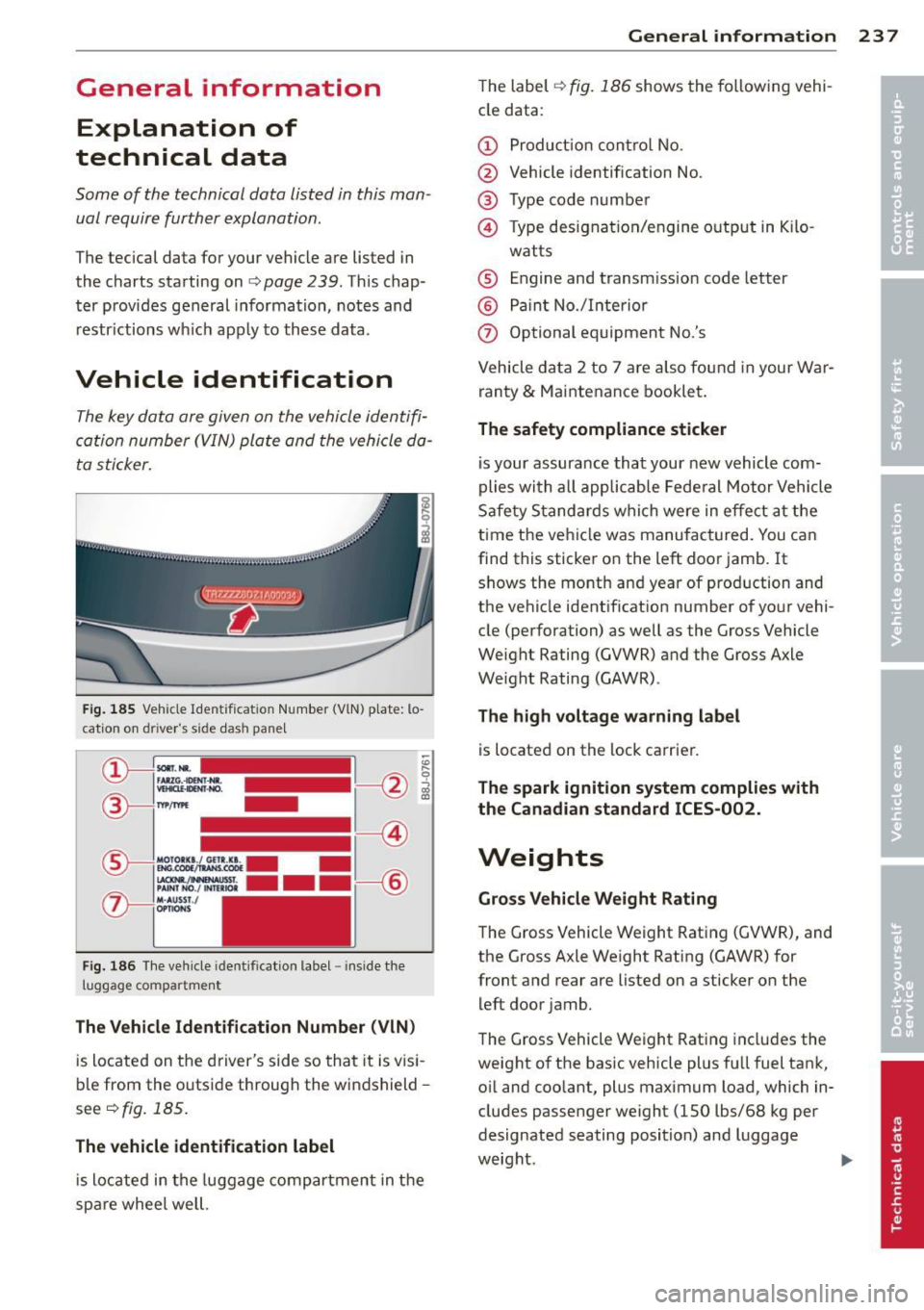
General information Explanation of
technical data
Some of the technical data listed in this man
ual require further explanation.
The tecical data for your vehicle are listed in
the charts starting on
c:> page 239 . This chap
ter p rovides general informa tion, notes and
restr ictions wh ich app ly to these data .
Vehicle identification
The key data are given on the vehicle identifi
ca tion number
(V IN) pla te and the vehicle da
ta sticker.
F ig. 1 85 Vehicle Ident ificat io n Num ber {V lN) p la te: lo
cation o n dr iver's s ide dash pa nel
Fi g. 18 6 Th e ve hicle ident ificat ion label -inside the
l u ggage co mpartme nt
The Vehicle Identification Number (VlN)
is located on the d river's side so tha t it is v is i
b le from the outside through the windshield -
see
c!) fig. 185.
The vehicle identification label
i s located in the luggage compartment in t he
sp are wheel well.
General inform ation 23 7
The label c:> fig. 186 shows the fo llow ing vehi
cle data :
(D Productio n con trol No .
@ Vehicle identification No.
@ Type code numbe r
@ Type designat ion/en gine o utp ut in K ilo -
watts
® Engine and t ransmission code letter
® Pa in t No./Interior
(J) Optional equipment No.'s
Vehicle da ta 2 to 7 are a lso fo und in your W ar
ran ty
& Maintenance booklet .
The safety compliance sticker is your assurance that your new vehicle com
plies wi th a ll applicab le Fede ral Motor Vehicle
S afety S tandards which were in effect at the
time the ve hicl e was manufactured. You can
find this sticke r on the left door jamb. It
shows the month and yea r of prod uction and
the vehicle ident ificat ion number of yo ur vehi
cle (perforation) as well as the Gross Vehicle
Weight Rating (GVWR) and the Gross Axle
Weight Rating (GAWR) .
The high voltage warning label is located on the lock carrier.
The spark ignition system complies with
the Canadian standard ICES-002.
Weights
Gro ss Vehicle Weight Rating
The Gross Vehicle Weight Rat ing (GVWR), and
the Gross Axle Weight Rating (GAWR) for
front and rear are listed on a sticker on the left door jamb.
The Gross Vehicle Weight Rat ing includes the
weight of the bas ic vehicle plus fu ll fuel tank,
oi l and coo lant, plus maximum load, which in
cludes passenger we ight (150 lbs/68 kg per
designated seating position) and luggage
weight .
Page 240 of 260
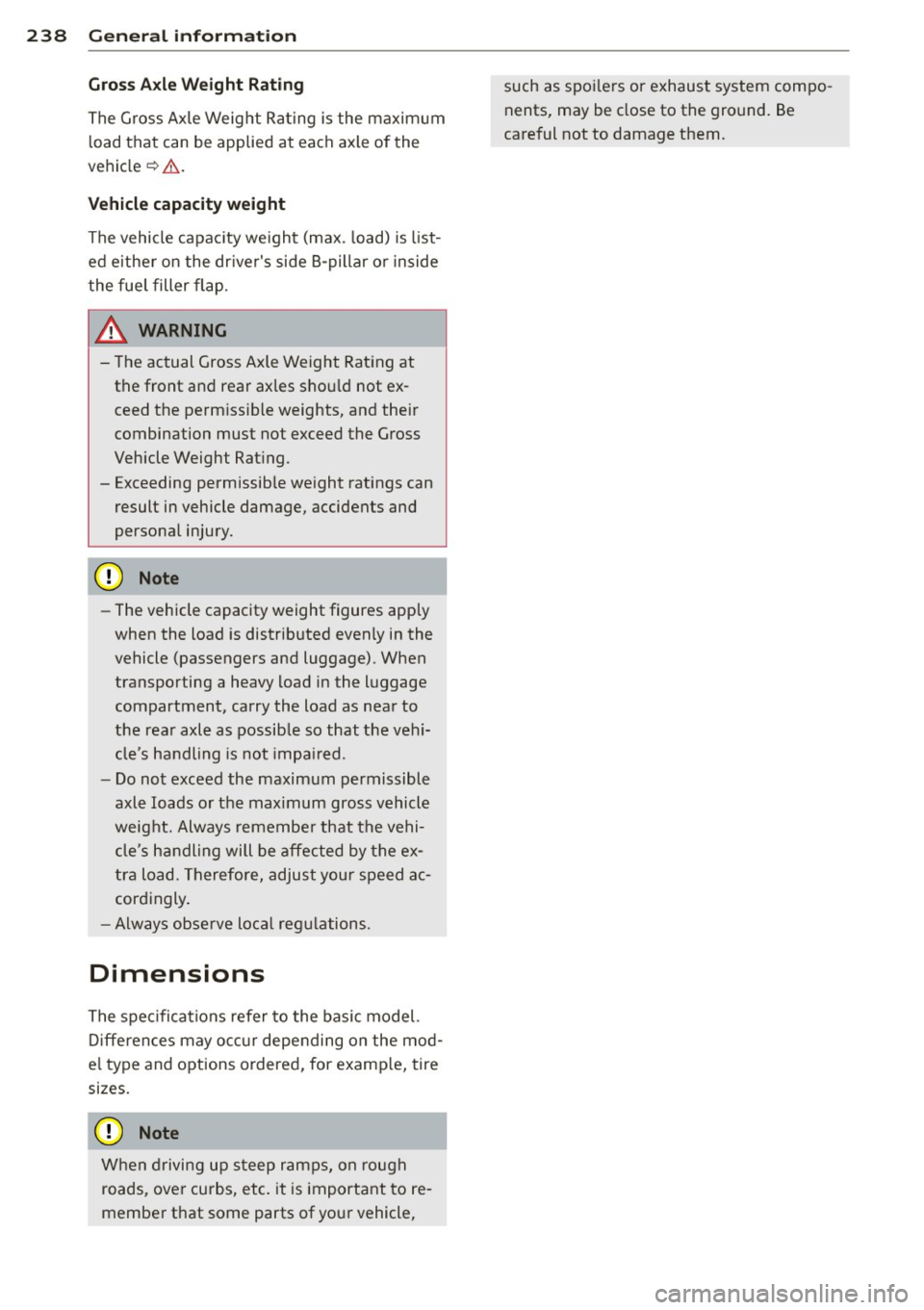
238 Genera l inform ation
G ro ss Ax le Weight Rating
The Gross Axle Weight Rating is the maximum
l oad that can be applied at each axle of the
vehicle ~&. .
Vehicle capacity weight
The vehicle capac ity we ight (max. load) is list
ed eithe r on the dr iver's side B-pillar or inside
the fuel filler flap.
A WARNING
- The actual Gross Axle Weight Rat ing at
the front and rear axles should not ex
ceed the perm iss ible weights, and their
combination must not exceed the Gross
Vehicle Weight Rat ing .
- Exceeding permissib le we ight ratings can
result in vehicle damage, accidents and
personal injury.
@ Note
- The vehicle capacity weight figures apply
when the load is distributed evenly in the
vehicle (passengers and luggage) . When
transporting a heavy load in the luggage
compartment, carry the load as near to
the rear axle as possible so that the vehi
cle's handling is not impa ired.
- Do not exceed the maximum permissible
axle loads or the maximum gross vehicle
weight. Always remembe r that the vehi
cle's handling will be affected by the ex
tra load. Therefore, adjust your speed ac
cordingly.
- Always obse rve loca l regu lations.
Dimensions
-
The spec ifications refer to the basic model.
Differences may occ ur depending on the mod
e l type and options ordered, for examp le, tire
sizes.
(D Note
When driving up steep ramps, on rough
roads, ove r curbs, etc. it is important to re
member that some parts of your vehicle, such as spoi
le rs or exhaust system compo
nents, may be close to the ground. Be
careful not to damage them.